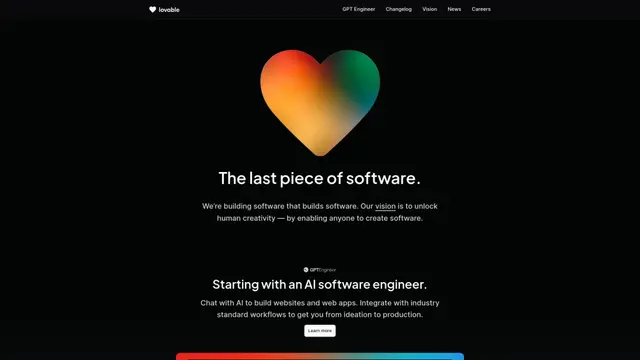
WeatherNext By Google
WeatherNext è la tecnologia di previsione meteorologica all'avanguardia basata su intelligenza artificiale di Google DeepMind che offre previsioni più rapide e accurate fino a 15 giorni in anticipo con una superiorità di affidabilità rispetto ai metodi di previsione tradizionali.
https://deepmind.google/technologies/weathernext?ref=aipure&utm_source=aipure

Informazioni sul Prodotto
Aggiornato:Dec 16, 2025
Tendenze del traffico mensile di WeatherNext By Google
WeatherNext di Google ha registrato un calo del 19,2% nel traffico, con visite scese a 4,9M. Il significativo declino potrebbe essere attribuito alla mancanza di recenti aggiornamenti del prodotto e alla maggiore concorrenza da parte di altri modelli avanzati di previsioni meteorologiche, come quelli del governo britannico e di altre aziende tecnologiche.
Cos'è WeatherNext By Google
WeatherNext è una nuova famiglia di modelli di intelligenza artificiale sviluppati da Google DeepMind e Google Research per rivoluzionare la previsione meteorologica. In un mondo di eventi meteorologici sempre più estremi, questa tecnologia combina l'apprendimento automatico avanzato con la scienza atmosferica per produrre previsioni meteorologiche altamente accurate. Il sistema è composto da due componenti principali - WeatherNext Graph per previsioni singole e WeatherNext Gen per previsioni di ensemble - entrambi progettati per superare i sistemi di previsione standard del settore attuale.
Caratteristiche principali di WeatherNext By Google
WeatherNext è la tecnologia di previsione meteorologica all'avanguardia basata su AI di Google DeepMind che combina due modelli principali: WeatherNext Graph e WeatherNext Gen. La tecnologia produce previsioni meteorologiche più rapide e accurate rispetto ai modelli tradizionali basati sulla fisica, offrendo previsioni sia deterministiche (singole) che di ensemble (multiple) fino a 15 giorni in anticipo. Il sistema elabora enormi quantità di dati per generare previsioni affidabili quattro volte al giorno, accessibili attraverso le piattaforme Google Cloud come BigQuery e Earth Engine.
Sistema a Modello Doppio: Combina WeatherNext Graph per previsioni deterministiche (previsioni singole) e WeatherNext Gen per previsioni di ensemble (scenari multipli), fornendo previsioni meteorologiche complete
Intervallo di Previsione Esteso: Capace di produrre previsioni meteorologiche accurate fino a 10-15 giorni in anticipo, con WeatherNext Gen che offre previsioni di ensemble di fino a 50 diversi scenari meteorologici
Alta Efficienza di Elaborazione: Genera previsioni in minuti piuttosto che in ore, con WeatherNext Gen che impiega solo 8 minuti su un chip Google Cloud TPU v5 per creare una previsione
Integrazione con Piattaforme Cloud: Accessibile attraverso i servizi Google Cloud tra cui BigQuery e Earth Engine, con previsioni in tempo reale aggiornate quattro volte al giorno e dati storici disponibili
Casi d'uso di WeatherNext By Google
Prevenzione e Risposta ai Disastri: Aiuta le autorità e i servizi di emergenza a prepararsi e rispondere a eventi meteorologici estremi come uragani e cicloni con avvisi anticipati più accurati
Gestione dell'Energia Rinnovabile: Assiste nell'ottimizzazione della generazione di energia rinnovabile fornendo previsioni accurate del vento e del sole per una migliore gestione della rete
Pianificazione della Catena di Fornitura: Consente alle aziende di pianificare meglio le loro operazioni logistiche e della catena di fornitura anticipando le interruzioni legate al meteo
Pianificazione Agricola: Aiuta gli agricoltori a prendere decisioni migliori riguardo alla semina, al raccolto e alla protezione delle colture fornendo previsioni meteorologiche accurate a medio termine
Vantaggi
Superiorità di accuratezza rispetto ai metodi di previsione tradizionali
Tempo di elaborazione significativamente più veloce rispetto ai modelli convenzionali
Capacità di gestire sia previsioni deterministiche che probabilistiche
Svantaggi
Richiede ancora modelli tradizionali per le condizioni meteorologiche iniziali e i dati di addestramento
Capacità limitata di prevedere alcune caratteristiche meteorologiche estreme come l'intensità degli uragani
Richiede risorse computazionali significative e hardware specializzato
Come usare WeatherNext By Google
Scegli il modello WeatherNext appropriato: Seleziona tra WeatherNext Graph (per previsioni singole di 10 giorni) o WeatherNext Gen (per previsioni di ensemble di 15 giorni) in base alle tue esigenze
Accedi a WeatherNext tramite Google Cloud: Vai alla Google Cloud Platform e scegli tra il metodo di accesso BigQuery o Earth Engine per il modello selezionato
Per l'accesso a WeatherNext Graph: Visita BigQuery (console.cloud.google.com/bigquery) o Earth Engine (developers.google.com/earth-engine) per accedere alle previsioni di singola previsione con risoluzione temporale di 6 ore fino a 10 giorni in anticipo
Per l'accesso a WeatherNext Gen: Accedi tramite BigQuery o Earth Engine per ottenere previsioni di ensemble (fino a 50 scenari) con risoluzione temporale di 12 ore fino a 15 giorni in anticipo
Richiedi accesso ai dati storici: Compila il modulo di richiesta dati WeatherNext se hai bisogno di accesso ai dati di previsione storici per scopi di ricerca
Accedi alle previsioni in tempo reale: Le previsioni live vengono aggiornate quattro volte al giorno e sono disponibili entro 48 ore dalla generazione tramite la piattaforma scelta
Per sviluppatori: Accedi al codice sorgente open source e alla documentazione tramite il repository ufficiale di GitHub su github.com/google-deepmind/graphcast
Cita in modo appropriato: Quando utilizzi dati storici, cita i modelli di apprendimento automatico di DeepMind Technologies Limited secondo i termini della licenza CC BY 4.0
FAQ di WeatherNext By Google
WeatherNext è una famiglia di modelli di intelligenza artificiale sviluppati da Google DeepMind e Google Research che producono previsioni meteorologiche all'avanguardia. È progettato per essere più veloce ed efficiente rispetto ai modelli meteorologici tradizionali basati sulla fisica, fornendo al contempo una maggiore affidabilità delle previsioni.
Articoli Popolari

Tendenza Foto Natalizie AI 2025: Prompt Virali, Generatori Gratuiti e Come Creare Splendide Foto Natalizie AI
Dec 23, 2025

ChatGPT Image 1.5 contro Nano Banana Pro: La battaglia per il miglior generatore di immagini AI nel 2025
Dec 18, 2025

ChatGPT Image 1.5 è qui: All'interno del nuovo modello di generazione di immagini AI di OpenAI nel 2025
Dec 18, 2025

OpenAI GPT-5.2 contro Google Gemini 3 Pro: Ultima Recensione 2025
Dec 18, 2025
Analisi del Sito Web di WeatherNext By Google
Traffico e Classifiche di WeatherNext By Google
4.9M
Visite Mensili
#16454
Classifica Globale
#25
Classifica di Categoria
Tendenze del Traffico: Nov 2024-Oct 2025
Approfondimenti sugli Utenti di WeatherNext By Google
00:01:07
Durata Media della Visita
1.61
Pagine per Visita
68.39%
Tasso di Rimbalzo degli Utenti
Principali Regioni di WeatherNext By Google
US: 20.59%
IN: 10.25%
GB: 4.26%
KR: 3.29%
CN: 2.9%
Others: 58.72%






